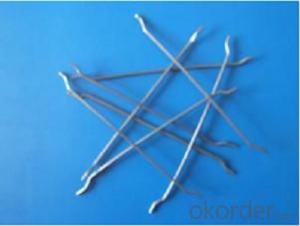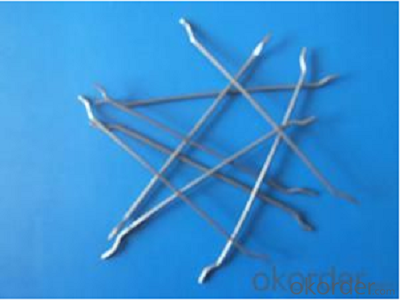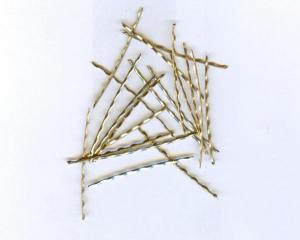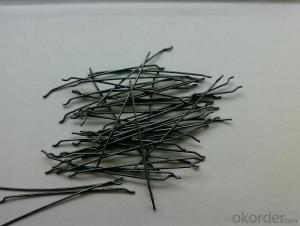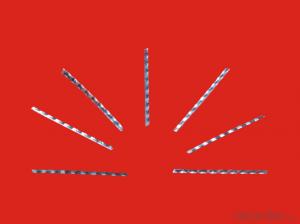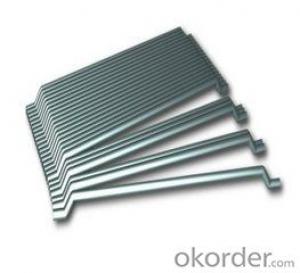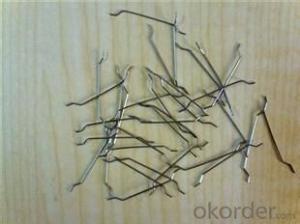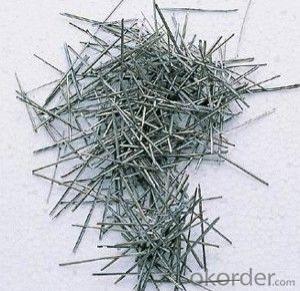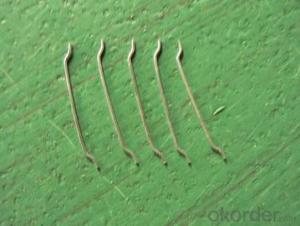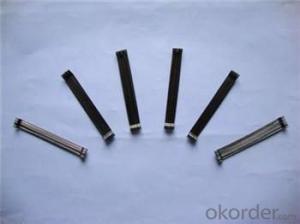Concrete Steel Fiber 0.9/55 From CNBM China
- Loading Port:
- Tianjin
- Payment Terms:
- TT or LC
- Min Order Qty:
- 1 m.t.
- Supply Capability:
- 5000 m.t./month
OKorder Service Pledge
OKorder Financial Service
You Might Also Like
Quick Details
Place of Origin: Tianjin, China (Mainland)
Model Number: 0.9
Material: Steel
Production Process: Cold drawn
Lengh: 55
Type: 1
Compressive Strength: >1200MPa
Aspect ratio: 61
Standard: ASTM A820M-11
Section Shape: Circular
Application: Concrete Reinforcement
Specifications
| Diameter | 0.90 | mm | 0.04 | in |
| Length | 55.00 | mm | 2.16 | in |
| Aspect Ratio | 61 | |||
| Tensile strength | 1200 MPa | |||
| Type | Cold drawn Steel Fiber | |||
| End | Hooked-end Steel Fiber | |||
| Glued/Loose | Glued Steel Fiber | |||
| Bending Angle | 45°(min.30°) | |||
| Usage & Performance | Floor:Trafficked areas and Industrial floors | |||
| Shotcrete :Slope stabilization and Final lining | ||||
| Precast concrete:Pipe and Railway sleepers | ||||
| Packing | Standard Export Pallet Packing | Bag Packing | 20 kg/Bag,50 bags/Pallet | |
| Bulk Packing | 1,000kg/ Bulk Bag | |||
| Loading Quantity | 20’GP | 20-25 Tonne/Tonnes | ||
| 40’GP | 25-27 Tonne/Tonnes | |||
| 40’HQ | 25-27 Tonne/Tonnes | |||
| MOQ | 1 kg for trial order | |||
| Supply Ability | 10,000 Tonne/Tonnes per Year | |||
| Payment Terms | T/T or L/C at sight | |||
| Delivery Time | Within 15 days after receiving deposit or original L/C at sight | |||
| Certification | ISO9001:2000, CE, | |||
| Product | Diameter | Length mm/in | Aspect Ratio | Type | Packing |
| G-6030 | 0.5 mm (0.0197 in) | 30 mm (1.1811 in) | 60 | Glued | 20 kg/Bag, or 1,000kg/ Bulk Bag |
| G-6535 | 0.55 mm (0.0217 in) | 35 mm (1.3780 in) | 65 | Glued | 20 kg/Bag, or 1,000kg/ Bulk Bag |
| G-6035 | 0.6 mm (0.0236 in) | 35 mm (1.3780 in) | 60 | Glued | 20 kg/Bag, or 1,000kg/ Bulk Bag |
| G-8060 | 0.75 mm (0.0295 in) | 60 mm (2.3622 in) | 80 | Glued | 20 kg/Bag, 50 bags/Pallet |
| G-6060 | 0.9 mm (0.0354 in) | 60 mm (2.3622 in) | 60 | Glued | 20 kg/Bag, 50 bags/Pallet |
| G-6030 | 0.5 mm (0.0197 in) | 30 mm (1.1811 in) | 60 | Loose | 20 kg/Bag, or 1,000kg/ Bulk Bag |
| G-6535 | 0.55 mm (0.0217 in) | 35 mm (1.3780 in) | 65 | Loose | 20 kg/Bag, or 1,000kg/ Bulk Bag |
| G-6035 | 0.6 mm (0.0236 in) | 35 mm (1.3780 in) | 60 | Loose | 20 kg/Bag, or 1,000kg/ Bulk Bag |
| G-8060 | 0.75 mm (0.0295 in) | 60 mm (2.3622 in) | 80 | Loose | 20 kg/Bag, 50 bags/Pallet |
| G-6060 | 0.9 mm (0.0354 in) | 60 mm (2.3622 in) | 60 | Loose | 20 kg/Bag, 50 bags/Pallet |
Picture
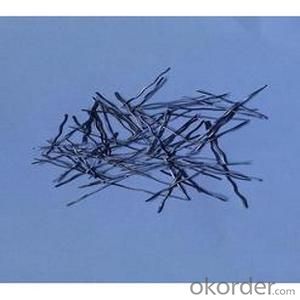
Steel fiber
FAQ
Technical advantages of Daye steel fiber:
A. Improve mechanical performance of concrete
B. Provide uniform distribution throughout concrete with excellent mixing
C. No balling or caking by adopt correct mixing method
D. Reduce concrete volume
E.Save construction time and cost
F.Reduce excavation volume
G.Available for jointless floor.
- Q:How does melt extract stainless steel fiber affect the resistance of concrete to sulfate attack?
- The resistance of concrete to sulfate attack is positively influenced by the inclusion of melt extract stainless steel fiber. Sulfate attack arises from the reaction between sulfate ions found in soil or water and specific compounds in concrete, which results in the creation of expansive substances that can lead to the deterioration of the concrete. The incorporation of stainless steel fibers into concrete acts as a reinforcement material, enhancing its overall durability and resistance to various forms of degradation, such as sulfate attack. These fibers aid in improving the concrete's ability to resist the infiltration of sulfate ions and reduce the formation of detrimental expansive substances. The utilization of the melt extraction process in the production of stainless steel fibers ensures a high degree of purity and a uniform dispersion throughout the concrete matrix. As a result, the bonding between the fibers and the surrounding concrete is enhanced, resulting in a stronger and more resilient material. Moreover, the corrosion-resistant characteristics of stainless steel fibers make them highly effective in preventing concrete deterioration caused by sulfate attack. In contrast to other fiber types, stainless steel fibers do not corrode when exposed to sulfate ions. This corrosion resistance helps to maintain the integrity of the concrete, preventing the formation of cracks or other types of damage that may occur due to the expansion of sulfate products. To conclude, the addition of melt extract stainless steel fiber to concrete enhances its resistance to sulfate attack by improving its ability to withstand the infiltration of sulfate ions and reducing the formation of expansive substances. The corrosion-resistant properties of stainless steel fibers further contribute to the long-term durability and performance of concrete in sulfate-rich environments.
- Q:What is the recommended spacing between melt extract stainless steel fibers in concrete?
- The spacing between melt extract stainless steel fibers in concrete can vary depending on several factors, including the intended use of the concrete, the type of structural element, and the desired performance characteristics. However, a commonly recommended range for spacing is between 1 inch (25 mm) and 2 inches (50 mm). This range allows for a sufficient distribution of fibers throughout the concrete matrix, which enhances its tensile strength, crack resistance, and durability. To ensure the proper spacing for the specific stainless steel fibers being used, it is important to refer to the product guidelines and engineering specifications provided by the manufacturer. Additionally, seeking guidance from a structural engineer or concrete expert can offer further insight tailored to the project requirements.
- Q:Can melt extract stainless steel fiber be used in tunnel linings for underground mining?
- Yes, melt extract stainless steel fiber can be used in tunnel linings for underground mining. Stainless steel fibers are known for their high tensile strength, corrosion resistance, and durability, making them suitable for demanding applications such as mining tunnels. These fibers can enhance the structural integrity of the lining by providing reinforcement and preventing cracks or fractures. Additionally, the stainless steel material is resistant to chemical reactions, moisture, and temperature fluctuations commonly encountered in underground mining environments. This makes it a reliable choice for tunnel linings that need to withstand various challenges and ensure long-term stability.
- Q:Can melt extract stainless steel fiber be used in ultra-high-performance concrete (UHPC)?
- Indeed, melt extract stainless steel fiber is a viable option for utilization in ultra-high-performance concrete (UHPC). UHPC is renowned for its outstanding robustness, endurance, and augmented performance attributes, and the inclusion of stainless steel fibers can further heighten these qualities. Melt extract stainless steel fibers are specifically engineered to enhance the tensile strength, malleability, and resistance to fissuring of concrete. Furthermore, they offer exceptional resistance to corrosion, which is pivotal for long-lasting sustainability in aggressive surroundings. Moreover, the diminutive diameter and elevated aspect ratio of these fibers facilitate enhanced dispersion and adhesion within the concrete structure, resulting in improved crack resistance and overall performance. Consequently, integrating melt extract stainless steel fibers in UHPC can significantly enhance its mechanical properties and lifespan, rendering it a suitable option for demanding applications such as skyscrapers, infrastructure undertakings, and precast elements.
- Q:Can melt extract stainless steel fiber be used in lightweight concrete wall panels?
- Yes, melt extract stainless steel fiber can be used in lightweight concrete wall panels. Stainless steel fibers are commonly added to concrete mixtures to improve the strength, durability, and crack resistance of the material. In lightweight concrete wall panels, stainless steel fibers can provide additional reinforcement without significantly increasing the weight of the panels. This allows for the creation of stronger and more stable lightweight concrete wall panels that can withstand various external forces and environmental conditions. Additionally, stainless steel fibers are corrosion-resistant, which further enhances the durability and lifespan of the wall panels. Therefore, melt extract stainless steel fiber is a suitable choice for reinforcing lightweight concrete wall panels.
- Q:Does melt extract stainless steel fiber enhance the flexural toughness of concrete beams?
- Concrete beams experience an enhancement in flexural toughness when melt extract stainless steel fiber is utilized. The inclusion of these fibers in concrete mixtures leads to a significant improvement in the beams' ability to withstand bending and flexural forces. By incorporating stainless steel fibers, the material's tensile strength and ductility are increased, resulting in a strengthened resistance to cracking and an overall improvement in toughness. This reinforcement ensures that applied loads are evenly distributed, reducing the likelihood of brittle failure and enhancing the structural performance of the concrete beams. Furthermore, the small size and high aspect ratio of melt extract stainless steel fibers enable better dispersion and bonding within the concrete matrix, further heightening their effectiveness in enhancing flexural toughness.
- Q:Can melt extract stainless steel fiber be used in concrete repair applications?
- Yes, melt extract stainless steel fiber can be used in concrete repair applications. Stainless steel fibers are commonly added to concrete mixtures to enhance its mechanical properties and durability. The melt extract stainless steel fibers are typically made using a specialized process that ensures high tensile strength and resistance to corrosion. These fibers can help improve the resistance to cracking, impact, and fatigue loading in repaired concrete structures. Additionally, the stainless steel fibers can also enhance the bond between the repaired concrete and the existing concrete surface, thereby improving the overall integrity of the repaired area.
- Q:What is the effect of melt extract stainless steel fiber on the freeze-thaw resistance of concrete?
- The addition of melt extract stainless steel fiber to concrete enhances its freeze-thaw resistance. The fibers help to reduce cracking and improve the overall durability of the concrete by providing reinforcement and preventing moisture penetration. This results in increased resistance to freeze-thaw cycles, where the repeated expansion and contraction of water within the concrete can cause damage.
- Q:Does melt extract stainless steel fiber affect the electrical conductivity of concrete?
- The electrical conductivity of concrete can be affected by the use of melt extract stainless steel fiber. When stainless steel fibers are incorporated into the concrete, they have the potential to enhance its electrical conductivity. This enhancement is achieved by the creation of a conductive network within the concrete matrix, enabling the flow of electrical current. This improved electrical conductivity is particularly advantageous in situations where electrical grounding or conductivity is necessary, such as when constructing electrostatic discharge (ESD) flooring or producing conductive concrete for electromagnetic shielding. However, it is essential to consider that the actual impact on electrical conductivity will vary depending on several factors, including the quantity and distribution of the stainless steel fibers in the concrete mixture.
- Q:Can melt extract stainless steel fiber be used in airport pavement applications?
- Yes, melt extract stainless steel fiber can be used in airport pavement applications. It provides enhanced strength and durability to concrete, making it suitable for heavy traffic areas like airports. The stainless steel fibers also offer resistance to corrosion and fatigue, ensuring a longer lifespan for the pavement.
1. Manufacturer Overview |
|
|---|---|
| Location | |
| Year Established | |
| Annual Output Value | |
| Main Markets | |
| Company Certifications | |
2. Manufacturer Certificates |
|
|---|---|
| a) Certification Name | |
| Range | |
| Reference | |
| Validity Period | |
3. Manufacturer Capability |
|
|---|---|
| a)Trade Capacity | |
| Nearest Port | |
| Export Percentage | |
| No.of Employees in Trade Department | |
| Language Spoken: | |
| b)Factory Information | |
| Factory Size: | |
| No. of Production Lines | |
| Contract Manufacturing | |
| Product Price Range | |
Send your message to us
Concrete Steel Fiber 0.9/55 From CNBM China
- Loading Port:
- Tianjin
- Payment Terms:
- TT or LC
- Min Order Qty:
- 1 m.t.
- Supply Capability:
- 5000 m.t./month
OKorder Service Pledge
OKorder Financial Service
Similar products
New products
Hot products
Hot Searches
Related keywords
